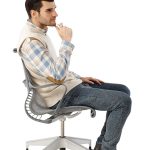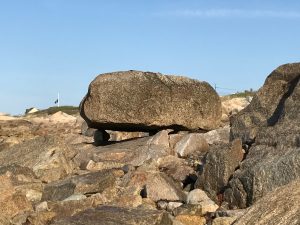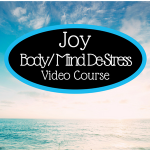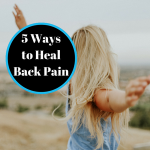This post may contain affiliate links.
Back pain can be debilitating! If you have back pain and neck pain you are not alone. According to the Mayo Clinic, back pain is the 3rd top reason people see their doctor.
Doctors at the University of North Carolina state that “Low back pain is the second most common cause of disability in the United States and a common reason for missing work.”
We all know that back pain is incredibly painful and can disrupt life in immeasurable ways.
Many of the treatments for back pain, whether invasive or non-invasive, may not be successful and can have lasting side effects.
Perhaps a new approach is needed.
Perhaps we need to shift the paradigm.
Perhaps it is not your back hurting you but rather you hurting your back.
Think about this. How you sit, how you stand, how you move could be creating unnecessary muscular tension. Unnecessary muscular tension can cause pain.
So the answer is to address how you move and reduce the amount of muscular tension you use while moving.
Would you agree that you don’t move like you did when you were a child?
Think about how a child moves. Effortlessly. A young child runs, jumps, hops, skips and tumbles all day long and never complains about a bad back, neck or knee.
Think about how they sit and stand. Their heads are beautifully poised on top of their spines.

Look at this adorable girl. See how her head and spine relate in a unified and lengthening way.

Compare her to this young man. Notice how his head and spine are compressed and that his back is not straight. He is slouching and his head is not poised on top of his spine.
This was FM Alexander’s observation way back in 1890: the way your head relates to your spine determines how well you function.
Better functioning means better movement. Better movement means less muscular tension. Less muscular tension means less pain.
5 Tips On What NOT To To To End The Cycle Of Back And Neck Pain.
1.Don’t try too hard! Trying hard just gets in your way. Trying brings about more muscular tension. Stop trying and start allowing. Just tell yourself that you are going to allow yourself to be right here and right now. Take a moment to let this sink in. Allow yourself to be where you are right now. What is that like?
2.Don’t slouch. When sitting, do you sit on your sitz bones? In order to sit up with any degree of ease, one needs to be sitting on the sitz bones. Do this: find a hard chair. A kitchen or dining room chair would be perfect. Sit on the chair and slide your hands palm up under your bum. Do you feel the boney bits? These are your sitz bones – otherwise known as your ischial tuberosities. Now slide your hands out. See how much better you are sitting? Many people sit back from their sitz bones and this forces them to slouch. So you see all the while your mother should have been telling you to sit on your sitz bones to improve your posture and not telling you to sit up straight.
3.Don’t clench your jaw, tongue, and neck.The primary principle in the Alexander Technique is that the relationship of your head and neck dictates how well you function and move. When you clench your jaw and tighten your tongue and neck you are interfering with this relationship and thus hurting your back. So tell yourself not to clench your jaw. Instead, tell yourself to soften your neck and tongue. See if this changes how you move.
4.Don’t try to sit up straight. If a parent or teacher ever told you so sit up straight you most probably very quickly felt pain, tension, and stiffness. You can’t try to sit up straight with any comfort or ease. Instead, pay attention to your head on top of your spine. Then pay attention to your sitz bones on the chair. Allow your spine to lengthen away from your pelvis towards your head. Remember don’t try! Allow instead!
5.Don’t go-go-go! Instead, stop and lie down. I would like to teach you a very simple practice that has a profound effect on how we move. It is called the Alexander Technique Lie Down. Lying down in this way resets you. It is kind of like rebooting your computer. We live in a go-go world and don’t pay much attention to stopping. Stopping is very important and lying down gives you the opportunity to stop and reorganize. It is preferable if you do this on the floor with carpeting or a yoga mat. If you cannot get down to the floor, no worries. You can do this in your bed but be sure to replace the pillows with books. Here is the sequence.
The Alexander Technique Lie Down For Back Pain and Neck Pain and Healthy Living
- Find a spot on the floor with carpeting or a rug. Place a pile of paperback books on the floor. This is where you will place your head.
- Sit on the floor with your back to the books. Lower your chin to your chest and roll down so that your head rests on the books. You should not have so many books that you tuck your chin, nor have too few books so that your head falls back onto the books. The book height is not a science. It may change throughout your lie down and it may change from lie down to lie down.
- Place your hands on your ribs. Bend your legs so that your feet are flat on the ground and your knees are pointing up to the ceiling.
- Lie this way for 15-20 minutes once or twice a day. If you cannot manage that length of time start with 5 minutes and build up.
- Think about allowing your head to release onto the books.
- Think about allowing your back to release onto the floor. This includes your upper back, your shoulders, your ribs, and your lower back. If you feel tightness in your lower back you can do a pelvic tilt.
- To get up off the floor, roll over into a fetal position and then get onto your feet.
I hope that you have found this useful. Let go of preconceived ideas about aging and free yourself up for easy movement.
Here is a link to an instructional video I made. Click here
So I’ve just given you a lot of information on what not to do to help your back pain. If you sit better, stand better and walk better you will move better. Better moving means less pain increased mobility and confidence. Better mobility is critical to living well. If you would like some more instruction on how to sit better you can sign up for my FREE video course Sitting for Success here.
If you would like to learn more ways to improve mobility and get out of pain sign up for my course 5 Ways to Heal Back Pain here.
Or you can get my Amazon bestselling book Agility at Any Age: Discover the Secret to Balance, Mobility, and Confidence here.
 My name is Mary Derbyshire. I am a fitness and movement coach. My methodology is the Alexander Technique, a mindfulness-based practice that teaches you how to move better. When you move better you feel better and when you feel better your whole life improves. You can get my Amazon best-selling book Agility at Any Age: Discover the Secret to Balance, Mobility, and Confidence here.
My name is Mary Derbyshire. I am a fitness and movement coach. My methodology is the Alexander Technique, a mindfulness-based practice that teaches you how to move better. When you move better you feel better and when you feel better your whole life improves. You can get my Amazon best-selling book Agility at Any Age: Discover the Secret to Balance, Mobility, and Confidence here.
1.Copyright: <a href=’https://www.123rf.com/profile_mcininch’>mcininch / 123RF Stock Photo</a>
2.Copyright: <a href=’https://www.123rf.com/profile_nyul’>nyul / 123RF Stock Photo</a>
3.Copyright: <a href=’https://www.123rf.com/profile_gpointstudio’>gpointstudio / 123RF Stock Photo</a>
4. Copyright: <a href=’https://www.123rf.com/profile_pisicasfioasa’>pisicasfioasa / 123RF Stock Photo</a>






 Here is my story.
Here is my story.


